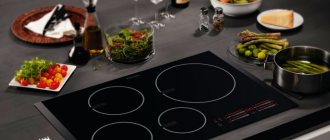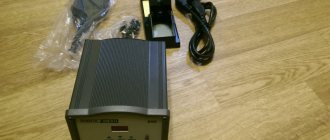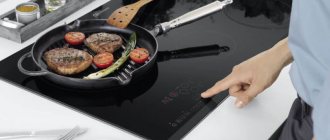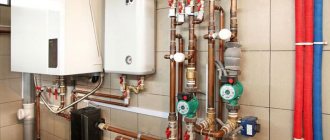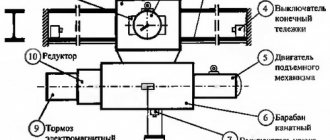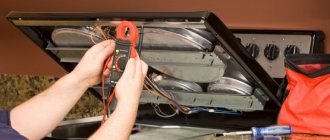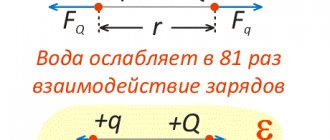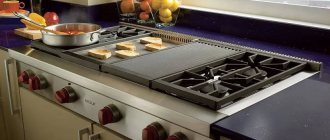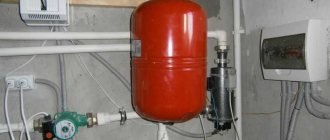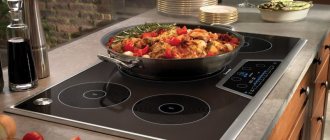SHARE ON SOCIAL NETWORKS
FacebookTwitterOkGoogle+PinterestVk
Choosing a hob for the kitchen is a responsible undertaking, on which the efficiency of the cooking process and the ease of use of the stove depend. Today, modern stoves are presented in several versions, which differ in operating principle, functionality, appearance and price. When deciding which is better: an induction or electric hob, it is important to study the strengths and weaknesses of each option.
Today, there are two types of hobs that are most popular: induction and electric.
Which is better, induction or electric hob: complete analysis
Many new residents choose modern models of induction or electric stoves instead of the old gas stove. This type of hob is often installed after a major overhaul or failure of an old kitchen stove. They are more than superior to conventional gas stove models, as they are much more efficient and easier to use. Also, new buildings do not always have a central gas supply, so people decide to acquire an autonomously operating stove.
At the time of purchase, a logical question arises: what is better to choose? To dot all the i's, you need to thoroughly understand the operating principle of an induction and electric panel and the difference between them.
How do hobs work?
An induction and electric stove with a glass-ceramic panel, although not much different at first glance, work completely differently.
In an electric stove, the energy supplied by the resistor is converted into heat. In other words, the current first heats the hob itself, and only after that the thermal energy is transferred to the cookware . This principle of operation is typical for both simpler models and advanced ones made using Hi-Light technology.
In an induction cooker, a high-frequency generator located under the burner creates eddy currents that are applied to the cookware. All cookware for an induction panel is a conductor , thanks to which thermal energy is directed to the pot or frying pan, bypassing the heating of the surface itself.
Due to the radically different operating principles, electric and induction cookers have their own pros and cons.
Harm to health
Today there is a lot of discussion regarding the harm of induction cookers, because the principle of their operation is based on electromagnetic fields, the negative effects of which are well known. Many experiments have been carried out on this matter.
Scientists have proven that at a distance of one centimeter from the source, electromagnetic radiation is always higher than the permissible ICNIRP standard.
If the pan is displaced relative to the center of the working surface or in a situation where its diameter is smaller than the diameter of the burner, the indicated indicator will be greater than the norm at a distance of up to 12 cm.
This parameter is typical for cases when special utensils are used for cooking. If there is an enameled object on the work surface, the danger zone is larger - up to 20 cm.
Why is this dangerous for health?
The electromagnetic field that occurs near the human body can lead to the appearance of induced currents in the body and a negative effect on the central nervous system. To protect health, ICNIRP has established requirements for upper current limits.
To verify whether induction cookers meet these standards, a study was conducted with a group of volunteers of different ages and genders.
People were located in close proximity to the hob (at a distance of five centimeters). Scientists at this moment studied the currents that flowed in the body and the central nervous system of the body.
It has been proven that the current indicators in the case of using built-in models are minimal.
As for portable models, their current indicators are higher, but they also did not exceed the established norm.
It is worth noting that the limit established by ICNIRP is 50 times less than the minimum threshold at which stimulation of the human central nervous system occurs.
What is the outcome of the study?
Experts published the results of the experiments, but admitted that there is not yet enough information about the dangers of electromagnetic fields. It is important to understand that the nature of such radiation may vary depending on the nature of its occurrence.
There is another study, the results of which can be found on the WHO website.
People and animals took part in the experiment, but it was not possible to prove the negative effect of electromagnetic radiation on the central nervous system or the cardiovascular system.
Electric hob: all the pros and cons
The advantages of this variety include the following indicators:
- slab models are made in a variety of colors, which allows you to create a harmonious interior design;
- heating occurs relatively quickly and smoothly;
- the air temperature in the room is maintained due to the residual thermal effect;
- no pan racks required;
- Convenient and easy cleaning of the stove.
Negative sides:
- has no surface deflection; due to its absence, spilled liquids spread everywhere;
- limited load weight;
- does not tolerate the ingress of substances that contain sugar;
- requires the use of cookware with a suitable bottom diameter and material of manufacture.
Advantages and disadvantages of an induction cooker
In recent years, this type of hob has received stunning success. Despite this, it has both advantages and disadvantages.
This is useful! Induction models at low prices
Its positive characteristics include the following indicators:
- in operation it is recognized as the safest model, since the dishes and their contents are heated, and not the working surface;
- a variety of cookware is suitable, including aluminum and enamel;
- many models are equipped with an additional safety system that prevents the burners from being turned on when there is no cookware on the stove;
- significant reduction in energy consumption.
The negative qualities of an induction cooker include the following characteristics:
- requires correct installation, it is prohibited to place it higher than a dishwasher, washing machine, or oven;
- You cannot use dishes that cannot be magnetized, that is, that do not have negative ferromagnetic properties;
- labor-intensive care, since it requires the use of special detergents that can be removed from the surface with a towel;
- does not tolerate substances and liquids with sugar.
Comparative characteristics
To figure out which panel is better and how they differ, let’s look at the table that compares the devices.
| Characteristics | Electric stove | Induction cooker |
| Heating rate | The cookware heats up in a couple of minutes | Heating occurs in a few seconds |
| Dishes | Utensils of different shapes are used | Use dishes with ferromagnetic properties and a smooth bottom |
| Control | Available in both touch and mechanical controls | Touch adjustment |
| Safety | There is a small chance of getting burned | The device is safe, but is not recommended for use by people with installed pacemakers |
| Energy Saving | Increased energy consumption | Low power consumption |
| Cleansing | Contaminants can be removed without much difficulty | Removing stains with a soft sponge |
| Noise | Low noise level | Quiet hum |
Choosing the right dishes
The electric stove is compatible with cookware made from a variety of materials. Uniform heating directly depends on the size and density of the material from which the cookware is made. In order for the hob to fully cope with the task, it is necessary to choose pots and pans with a flat, thick bottom.
Important! It is not recommended to use thin-walled dishes, which are more susceptible to deformation due to periodic temperature changes. The size of the cookware must match the diameter of the burners. If the pan is smaller than the burner, there is a constant loss of heat energy.
If ducklings, grill pans and other dishes with an asymmetrical shape are often used, then you should choose an electric panel model with elongated oval burners or burners with several contours.
In this regard, an induction hob is more demanding than an electric one. Despite the fact that absolutely any diameter of cookware is suitable, the main criterion is the presence of ferromagnetic properties in the material of manufacture . When purchasing a new stove, do not rush to completely update your kitchen utensils. You can buy special cookware for induction stoves, and you can also use old enamel and cast iron pans, as they are prone to “magnetism”.
There is an alternative option for using the induction surface, which requires a magnetic adapter disk. With its help, thermal energy is directed to the bottom of the cookware, so you can avoid buying kitchen utensils with a magnetic bottom. It seems that you have saved the family budget, but in reality this is not the case. With the help of a magnetic adapter disk, the induction furnace begins to work on the electric principle, which leads to a significant consumption of electricity .
Heating rate
Meticulous users, to find out which stove heats faster, carried out real measurements. To do this, we took two pans of the same type with the same temperature of water and body walls.
Next, we needed to find out which stove would boil water faster? Induction has always coped with this task several times faster than simple electric.
This is again explained by the exclusion of an extra intermediary from the process. Everything is elementary.
Fewer elements to transfer heat, faster heating. Is this always convenient? It turns out not.
For example, when heating something liquid with solid pieces, the liquid will boil quickly, but these same pieces will not warm up immediately. With such food, it is better to initially set the power a little lower.
By the way, manufacturers of cheap induction cookers often deceive their customers. A circle of a burner of the same size is drawn on the surface, but in fact, inside there is an inductor coil of a much smaller diameter.
Hence the lower heating rate and greater overheating of the central zone. As a result, all the food that gets into the center of the frying pan will burn, and vice versa at the edges.
How can you find out at home without disassembling the panel? Elementary. Place a frying pan much larger than the circle drawn on the stove, pour water into it and turn it on to maximum.
After a minute, you will see the actual diameter of the heating zone from the bubbles formed.
Every housewife can find out in this simple way how good and high-quality the induction hob was sold to her. Remember that a small inductor on a large pan gradually leads to uneven heating and deformation of the bottom.
Ease of use
When using an electric hob, you will need a huge amount of patience. This is exactly what will help you prepare food without nerves and come to terms with slow heating or cooling of dishes . If the electric stove burner heats up instantly, the cookware gradually increases and decreases temperature. To reduce the “fire”, you will need to go through the stages of a gradual decrease in temperature.
The induction surface is much more convenient in this regard. It instantly heats the dishes and quickly resets the temperature .
For maintenance, both models require the use of a separate sponge and detergents designed for cleaning glass-ceramic surfaces.
Noise level
According to this indicator, the induction furnace passes on the laurels of the winner to the electric one. The latter is absolutely silent in operation, while the former constantly shows signs of “life”. It makes various sounds, crackles every time the transistor radiator and the fan, hidden from view , are turned on, responsible for cooling the coil.
The resulting noise is not particularly annoying, and over time, stove users do not notice the sounds and completely get used to the “induction” operating mode.
How safe are household appliances?
Unlike conventional electric stoves, modern models are safer to use. Comparing electric and induction hobs, we can say that the former are significantly inferior to the latter in terms of safety. In addition to the fact that an induction cooker does not heat its surface, it does not require increased vigilance during cooking, as happens when working with an electric one.
Also produced models of hobs (both induction and electric) have additional functions:
- child protection and control lock;
- overheat protection;
- residual heat indicator;
- auto shutdown;
- utensil recognition sensor.
Price
An induction panel, despite being economical to use, is more expensive than its electric counterpart. The more features it has, the higher the price. Also, when installing the device, it is necessary to replace the old electrical wiring and select a separate electrical group with a separate circuit breaker, because the household appliance is quite powerful. This entails additional costs.
Compared to induction, an electric stove is a familiar and inexpensive technique, which also does not require the purchase of special utensils.
In pursuit of savings
When buying a hob, it is important not only to look at the cost of the model, but also to calculate how much its operation costs. From the above advantages, the conclusion suggests itself: an induction furnace uses electricity more economically, so its operation is much cheaper. But at the same time , the price of a new induction cooker is higher than an electric stove .
It is also worth considering the cost of purchasing new cookware if there is no hob suitable for the burners.
Induction cooker or electric: reviews on forums
We looked at a lot of reviews on various forums and would like to share some of them with our readers (spelling and punctuation preserved):
In my previous apartment I had an electric hob, now it’s induction... this is heaven and earth, in my opinion, and the most important thing for me is in the matter of maintaining the appearance of the stove - if I endlessly cleaned, scrubbed, scrubbed the glass electric hob - after all, it’s enough if you “missed” pasta or potatoes and all the liquid that overflowed instantly burned on this surface, then with induction it’s just relaxation - even if the porridge overflows over the edge - you just take a cloth and wipe it off and that’s it, not a single spot in one movement and there is no smell, even if milk “ran away” is a super trick, in my opinion.
Compared to all others, induction heats water faster and heats up the work area significantly less. The surface of the stove is heated only by the cookware itself, unlike other designs. When cooking, you can cover the entire surface with a paper towel so that you don’t have to wipe it later or use chemicals.
We were happy with the induction from Artiston for a year, until my husband dropped the mug on the very edge, a crack went through two burners, I don’t know if it can be used now.
I have ordinary glass ceramics, and once I was visiting a friend, she had an induction cooker. I realized that I need to adapt here, it heats up so quickly that the food burns instantly.
Multifunctionality
An experienced housewife will even prepare a 10-course festive dinner on her grandmother’s stove with cast iron burners. It is possible - but very difficult.
The induction cooker is controlled automatically. The owner simply selects the desired program, presses a button, and the process begins.
The stove will monitor the escaping milk, turn off the burners if a cat stands on the stove, and heat the dish by the specified time. You can increase the power of one burner by transferring energy to it from another, idle one. You can combine two burners into one.
Display, smooth temperature control, touch panels... A high-quality induction cooker is very convenient.
A modern electric stove cannot withstand competition. This technique also has super convenient controls - but there are no programs for preparing specific dishes.
conclusions
So, after weighing all the pros and cons, the buyer will have to make a choice in favor of an electric or induction surface. Each of them has its own advantages, which can compensate for the disadvantages and thereby seduce the future owner.
If you are not ready to immediately shell out a tidy sum for an induction cooker, then be prepared to pay a significant amount of monthly utility bills for using an electric stove. In most indicators, the induction surface wins and outperforms the electric one.
If you always have children in your kitchen, then an induction hob will also be the best option from a safety point of view.
However, if you are not ready to buy special cookware, then your choice is an electric stove.
Inertia
What is this indicator and what does it mean? Inertia is the time of heat retention after a power outage. Roughly speaking, how long does it take for the panel to cool down?
In some cases, food requires a certain time during the cooking process to “reach” the desired consistency - the simmering effect.
And here this same inertia will come in handy. If you reduce the temperature on an electric stove or turn it off completely, it will not cool down immediately.
In this regard, induction is closer to gas. I turned it off and the temperature immediately dropped. This is especially useful when something boils or “runs away” from the pan, and you need to instantly reduce the temperature. Here, excessive inertia seems to be a problem.
To create the effect of inertia, the induction cooker has a pulsed simmer mode. That is, on “low heat” the low boiling power is regulated something like this: it heats for 3 seconds, not for 3 seconds.
At this time, the water will either boil or cool, which is not very convenient and will give an unpredictable cooking result. The problem is partly solved by using dishes with a thick multi-layer bottom.
Based on the above, it is impossible to give an unambiguous answer to the question of which type of slab is better and which is worse in terms of inertia. Each housewife decides for herself.
